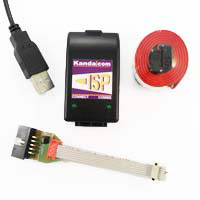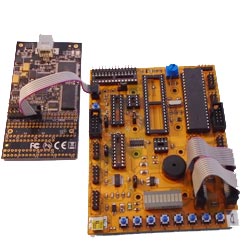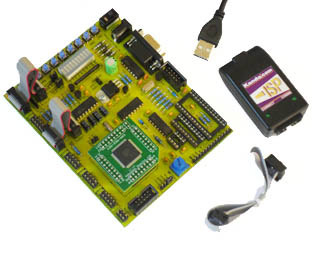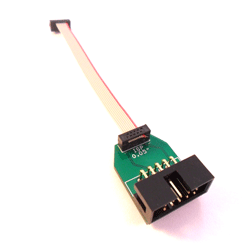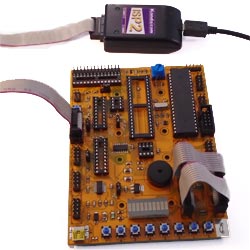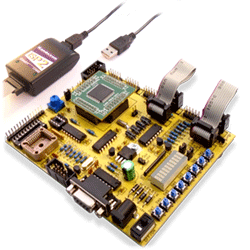/* Program to drive LCD on STK200 board normally for Hitachi type
16 x 2 LCD, but will work on other LCD sizes. For STK300, RD and
WR need to be on PORTG - see schematic.
This program uses Busy Flag on LCD (PORTA.7) instead of delays
between each instruction. The current LCD address is read at same
time but not used in this program.
Change to correct device in Project - Configuration Options */
//change to match target clock
//Note: default AVR CLKSEL is 1MHz internal RC
#define F_CPU 8000000UL
#include <avr/io.h>
#include <util/delay.h>
// used pins on port C and D
#define LCD_E 7 // PORTC.7
#define LCD_RS 6 //PORTC.6
#define LCD_RD 7 // PORTD.7
#define LCD_WR 6 // PORTD.6
// Data and Busy flag are on PORTA
//LCD commands
#define LCD_CLR 0x01 // clear LCD
#define LCD_8BIT 0x38 // 8-bit mode
#define LCD_INC 0x06 //Increment, display freeze
#define LCD_MOV 0x10 //Cursor move, not shift
#define LCD_ALL 0x0F // LCD On, LCD display on, cursor on and blink on
#define LCD_ON 0x08 // turn lcd/cursor on
#define LCD_ON_DISPLAY 0x04 // turn display on
#define LCD_ON_CURSOR 0x02 // turn cursor on
#define LCD_ON_BLINK 0x01 // cursor blink
#define LCD_LINE1 0x80 // cursor Pos on line 1 (or with column)
#define LCD_LINE2 0xC0 // cursor Pos on line 2 (or with column)
//LCD_getaddress reads the address counter and busy flag. For the address only,
//mask off bit7 of the return value.
unsigned char LCD_getaddr(void)
{
unsigned char address;
PORTC &= ~((1<<LCD_RS)|(1<<LCD_E));
//RS low for busy flag read and enable low
//RD pin low (for enable circuit)
PORTD &= ~(1<<LCD_RD);
// WR connected to read/write pin - high for read
PORTD |= (1<<LCD_WR);
//PortA is input
DDRA = 0;
PORTC |= (1<<LCD_E); // enable high
// short delay
asm volatile ("nop");
asm volatile ("nop");
//while E is high, get data from LCD
address = PINA;
PORTC &= ~(1<<LCD_E); // E low (for strobe)
// restore other settings
PORTD |= (1<<LCD_RD); // RD pin high (for enable circuit)
PORTD &= ~(1<<LCD_WR); // WR read/write goes low for write
DDRA = 0xFF; //back to output
//return address and busy flag
return address;
}
//LCD_wait reads the address counter (which contains the busy flag) and loops until
//the busy flag is cleared.
void LCD_wait(void){
//get address and busy flag
//and loop until busy flag (bit7) cleared
while((LCD_getaddr() & 0x80) == 0x80)
{
}
}
/*LCD_putchar writes a character to the LCD at the current address,
usage: LCD_putchar('A'); or LCD_putchar(0x55); */
void LCD_putchar(unsigned char data){
LCD_wait(); // is it busy?
//PortA is output
DDRA = 0xFF;
//RS high for data and Enable high
PORTC |= ((1<<LCD_RS)|(1<<LCD_E));
//put data on bus
PORTA = data;
/*the number of nops required varies with your clock frequency,
Can be altered */
asm volatile ("nop");
asm volatile ("nop");
asm volatile ("nop");
asm volatile ("nop");
// Enable low again
PORTC &= ~(1<<LCD_E);
//release port
DDRA = 0;
}
/*LCD_command works EXACTLY like LCD_putchar, but takes RS low for
accessing the command reg */
void LCD_command(unsigned char command){
LCD_wait(); // is it still busy?
DDRA = 0xFF; // data port as output
PORTC &= ~(1<<LCD_RS); //RS low for Command
PORTC |= (1<<LCD_E); //Enable pin high
PORTA = command; // put data on Port
asm volatile ("nop");
asm volatile ("nop");
asm volatile ("nop");
asm volatile ("nop");
PORTC &= ~(1<<LCD_E); //Enable Pin Low
DDRA = 0; // release bus
}
/*LCD_init initialises the LCD with the following paramters:
8 bit mode, 5*7 font, 2 lines (also for 4 lines)
auto-inc cursor after write and read
cursor and display on, cursor blinking.*/
void LCD_init(void){
//setup the LCD control signals on PortC (RS and Enable as output)
DDRC |= ((1<<LCD_RS)|(1<<LCD_E));
PORTC &= ~((1<<LCD_RS)|(1<<LCD_E));// set both low
//setup the LCD control signals on PortD
DDRD |= ((1<<LCD_RD)|(1<<LCD_WR));// read and write pins (STK300 on PortG)
PORTD &= ~(1<<LCD_WR); // write pin low
// data Port A as output
DDRA = 0xFF;
/*if called right after power-up, we'll have to wait a bit (fine-tune
for faster execution) */
_delay_ms(50);
LCD_command(LCD_CLR); // clear display
LCD_command(LCD_8BIT); // set 8 data bits
LCD_command(LCD_INC); // cursor increments automatically
LCD_command(LCD_MOV); // cursor set to move
//LCD_command(LCD_ALL); // can call all instead of next line
LCD_command(LCD_ON | LCD_ON_DISPLAY | LCD_ON_CURSOR | LCD_ON_BLINK);
LCD_command(LCD_LINE1); // set cursor to row 1, position 0
}
// function for showing strings on the LCD. It uses the low-level
//functions above. usage example: LCD_write("Hello World!");
void LCD_write(char* dstring){
//is the character pointed at by dstring a zero? If not, write character to LCD
while(*dstring)
{
// write the character from dstring to the LCD, then post-inc the string pointer.
LCD_putchar(*dstring++);
}
}
int main( void )
{
LCD_init();
LCD_write("Hello World");
LCD_command(LCD_LINE2 | 5); // move cursor to row 2, position 5
LCD_write("is here");
}
/*Note: As LCD has a RAM memory, it will display what was written
until its power is removed hence no loop needed */
If you found this information useful, please give us a mention or share it on Social media.





